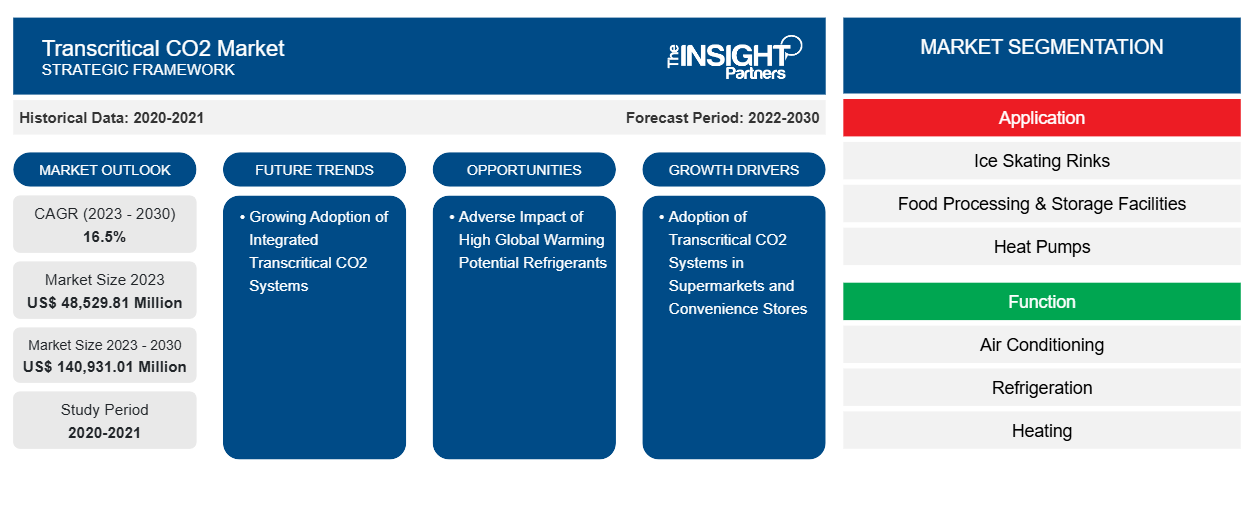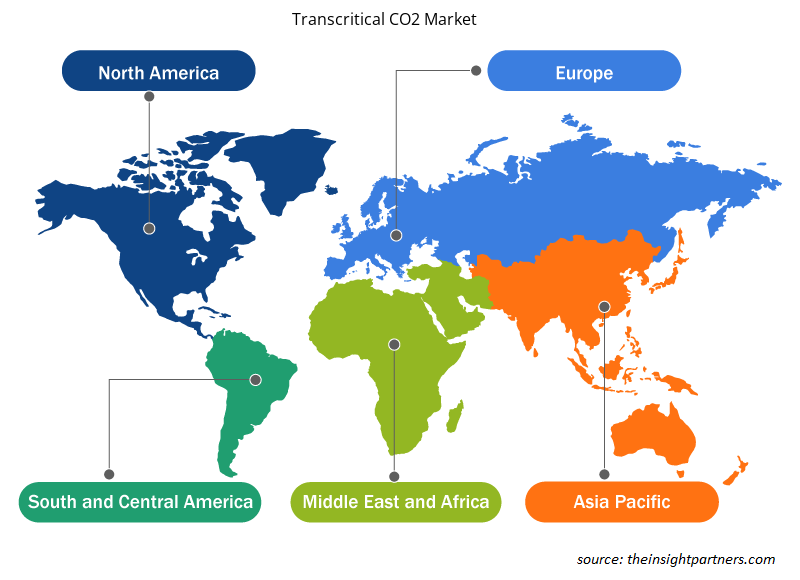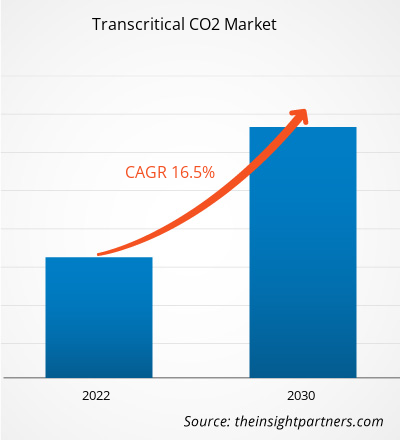Si prevede che il mercato della CO₂ transcritica raggiungerà i 156,99 miliardi di dollari entro il 2031, rispetto ai 54,15 miliardi di dollari del 2024. Si stima che il mercato registrerà un CAGR del 16,8% nel periodo 2025-2031. L'utilizzo di CO₂ riciclata dai rifiuti nelle applicazioni di refrigerazione porterà probabilmente nuove tendenze di mercato nei prossimi anni.
Analisi del mercato della CO2 transcritica
I sistemi a CO₂ transcritici sono prevalentemente adatti alle strutture di stoccaggio a freddo, offrendo un raffreddamento costante con un impatto ambientale ridotto. La rapida crescita del settore della catena del freddo, trainata dalla crescente domanda di alimenti surgelati e deperibili, è un fattore determinante nella necessità di questi sistemi per scopi di raffreddamento. Le innovazioni nei sistemi a CO₂ transcritici hanno contribuito a superare alcune delle sfide del passato, come l'inefficacia a temperature ambiente elevate. Sviluppi come la tecnologia degli eiettori e la compressione parallela hanno migliorato le prestazioni dei sistemi transcritici nei climi più caldi, favorendone l'applicabilità in tutto il mondo.
Panoramica del mercato della CO2 transcritica
Il mercato della CO₂ transcritica ruota attorno all'applicazione dell'anidride carbonica (CO₂) come refrigerante nei sistemi transcritici. Un sistema a CO₂ transcritica funziona al di sopra della pressione critica della CO₂, rendendolo estremamente efficiente in applicazioni come la refrigerazione e il riscaldamento. Questi sistemi stanno guadagnando terreno grazie al loro funzionamento ecocompatibile, all'efficienza dei costi e alla conformità alle normative, che li allineano agli obiettivi di eliminazione graduale dei refrigeranti sintetici ad alto potenziale di riscaldamento globale (GWP). Nel contesto della continua urbanizzazione in regioni in via di sviluppo come Asia-Pacifico, Africa e Sud America, la crescente penetrazione dei supermercati in India e Brasile crea un'opportunità significativa per l'adozione di sistemi a CO₂ transcritica. Anche i governi di queste regioni stanno adottando politiche ambientali che incoraggiano l'applicazione di refrigeranti naturali. Oltre alla vendita al dettaglio e alla lavorazione alimentare, settori come quello farmaceutico, chimico e dei data center stanno utilizzando sistemi a CO₂ transcritica per le loro esigenze di raffreddamento.
Riceverai la personalizzazione gratuita di qualsiasi report, incluse parti di questo report, analisi a livello nazionale, pacchetto dati Excel e potrai usufruire di fantastiche offerte e sconti per start-up e università.
Mercato della CO2 transcritica: approfondimenti strategici

-
Scopri le principali tendenze di mercato di questo rapporto.Questo campione GRATUITO includerà analisi di dati che spaziano dalle tendenze di mercato alle stime e alle previsioni.
Driver e opportunità del mercato della CO2 transcritica
Aumento della domanda di aria condizionata a basso consumo energetico nei data center in Nord America e in Europa
Il crescente numero di data center avvantaggia il mercato transcritico della CO2. Considerati i significativi livelli di consumo energetico nelle operazioni dei data center, i progettisti devono offrire sistemi di climatizzazione affidabili ed efficienti dal punto di vista energetico per queste strutture. L'Europa vanta una presenza significativa di un fiorente settore dei data center, con importanti hub come Francoforte, Londra, Amsterdam, Parigi e Dublino. Anche mercati emergenti come Milano, Varsavia e Berlino stanno vivendo una rapida espansione. Con la crescente dipendenza dai servizi digitali, i data center stanno diventando la spina dorsale dell'economia digitale europea. Interconnessi tramite reti robuste, questi hub di dati facilitano l'accesso senza interruzioni a Internet, supportando infine le operazioni in vari settori cruciali, come la medicina, le scienze biologiche e il settore bancario. Gli operatori di data center in tutta la regione stanno progressivamente dando priorità alla sostenibilità, spinti dalle severe normative UE sulle emissioni di carbonio. Negli Stati Uniti, il Texas è diventato uno degli hub di data center in crescita, grazie alle notevoli attività degli operatori hyperscale. La regione occidentale degli Stati Uniti si posiziona come un mercato sviluppato per i data center, ospitando tutte le principali aziende come Meta (ex Facebook), Google e Microsoft in località importanti come Idaho, Oregon, California e Utah.
A marzo 2024, Carrier ha introdotto i refrigeratori a vite raffreddati ad aria AquaForce 30XF con sistema di free-cooling idronico combinato e azionamenti inverter a velocità variabile, progettati per offrire un'efficienza energetica fino a circa il 50%, specificamente pensati per i data center. I refrigeranti a base di HFC vengono utilizzati in alcune apparecchiature dei data center, tra cui unità di condizionamento dell'aria per sale computer (CRAC), refrigeratori e alcuni sistemi di raffreddamento in-row. Diversi operatori di data center su larga scala si stanno impegnando per ridurre la loro dipendenza dai refrigeratori e sono passati a strategie di free-cooling che prevedono unità di trattamento aria e aria fresca come alternative. I refrigeranti sono comunemente utilizzati nei data center aziendali per supportare data center di grandi dimensioni e per service provider in climi più caldi, dove il free-cooling non è pratico. I refrigeranti naturali sotto forma di CO2 sono ampiamente utilizzati nei sistemi di raffreddamento industriali e commerciali. Pertanto, la crescente domanda di sistemi di condizionamento e raffreddamento ad alta efficienza energetica fornisce una spinta al mercato della CO2 transcritica.
Crescente importanza dei refrigeranti a CO2 nei settori alimentare, delle bevande e farmaceutico
Nel settore alimentare e delle bevande, i refrigeranti vengono utilizzati principalmente per mantenere un ambiente a temperatura controllata per la conservazione di alimenti e bevande. La domanda di alimenti trasformati, in scatola e facili da preparare è in aumento negli Stati Uniti, a causa della continua urbanizzazione, dell'aumento del reddito disponibile e degli stili di vita frenetici. Inoltre, il loro sapore e la praticità di cottura li rendono popolari tra i giovani del paese. Gli alimenti in scatola o pronti richiedono strutture di conservazione adeguate per mantenere la loro appetibilità. Gli alimenti trasformati hanno un'alta probabilità di marcire nel giro di pochi giorni o settimane se non vengono conservati correttamente. Una temperatura ottimale e condizioni di conservazione adeguate sono fondamentali per prolungare la durata di conservazione degli alimenti trasformati o in scatola, il che si traduce in una maggiore domanda di refrigeranti. Pertanto, supermercati e minimarket hanno in genere un impatto ambientale significativo a causa della loro dipendenza da sistemi di refrigerazione per lo stoccaggio di merci deperibili. La crescente importanza della sostenibilità e della responsabilità ambientale sottolinea la necessità di ridurre l'impronta di carbonio e le emissioni di gas serra associate a questi sistemi di raffreddamento. La necessità di abbandonare i refrigeranti ad alto GWP, quindi, rappresenta un'opportunità di crescita per i fornitori di sistemi a CO2 transcritica. Poiché i sistemi a CO2 transcritica contribuiscono ad alleviare l'impatto ambientale legato ai refrigeranti convenzionali e ad allinearsi agli obiettivi di sostenibilità, la domanda di soluzioni sostenibili continuerà a favorire anche in futuro il mercato della CO2 transcritica.
Analisi della segmentazione del rapporto di mercato sulla CO2 transcritica
I segmenti chiave che hanno contribuito alla derivazione dell'analisi di mercato della CO2 transcritica sono applicazione e funzione.
- In termini di applicazione, il mercato è suddiviso in piste di pattinaggio su ghiaccio, impianti di lavorazione e stoccaggio alimentare, pompe di calore, supermercati e minimarket, e altri. Il segmento dei supermercati e dei minimarket ha dominato il mercato nel 2024.
- In base alla funzione, il mercato è suddiviso in condizionamento dell'aria, refrigerazione e riscaldamento. Il segmento della refrigerazione ha dominato il mercato nel 2024.
Analisi della quota di mercato della CO2 transcritica per area geografica
Il mercato della CO₂ transcritica è segmentato in cinque regioni principali: Nord America, Europa, Asia-Pacifico (APAC), Medio Oriente e Africa (MEA) e Sud e Centro America (SAM). Il Nord America ha dominato il mercato nel 2024, seguito da Europa e Asia-Pacifico.
Il mercato della CO₂ transcritica è segmentato in cinque regioni principali: Nord America, Europa, Asia Pacifico (APAC), Medio Oriente e Africa (MEA) e Sud e Centro America. Nel 2024, l'Europa ha guidato il mercato con una quota di fatturato sostanziale, seguita dall'Asia Pacifico. Inoltre, si prevede che il Nord America registrerà il CAGR più elevato nel mercato della CO₂ transcritica dal 2025 al 2031. Il mercato della CO₂ transcritica in Europa è suddiviso in Germania, Francia, Italia, Regno Unito, Russia e resto d'Europa. La regione ha registrato un aumento del numero di impianti di stoccaggio a freddo. Secondo l'European Cold Storage & Logistics Association (ECSLA), l'Europa dispone di migliaia di celle frigorifere con una capacità di stoccaggio a freddo di oltre 60.000 m³ per varie merci. Inoltre, i paesi europei hanno implementato norme e regolamenti per un controllo rigoroso delle emissioni di gas serra fluorurati e di sostanze che riducono lo strato di ozono. Pertanto, con la legge sui gas fluorurati e il piano di eliminazione graduale degli HFC, si prevede che in futuro il mercato dei sistemi a CO2 transcritica in Europa crescerà a un ritmo notevole.
Approfondimenti regionali sul mercato della CO2 transcritica
Le tendenze e i fattori regionali che influenzano il mercato della CO2 transcritica durante il periodo di previsione sono stati ampiamente spiegati dagli analisti di Insight Partners. Questa sezione illustra anche i segmenti e la geografia del mercato della CO2 transcritica in Nord America, Europa, Asia-Pacifico, Medio Oriente e Africa, e America meridionale e centrale.

- Ottieni i dati specifici regionali per il mercato della CO2 transcritica
Ambito del rapporto sul mercato della CO2 transcritica
| Attributo del report | Dettagli |
|---|---|
| Dimensioni del mercato nel 2024 | 54,15 miliardi di dollari USA |
| Dimensioni del mercato entro il 2031 | 156,99 miliardi di dollari USA |
| CAGR globale (2025-2031) | 16,8% |
| Dati storici | 2021-2023 |
| Periodo di previsione | 2025-2031 |
| Segmenti coperti |
Per applicazione
|
| Regioni e paesi coperti |
America del Nord
|
| Leader di mercato e profili aziendali chiave |
|
Densità degli operatori del mercato della CO2 transcritica: comprendere il suo impatto sulle dinamiche aziendali
Il mercato della CO₂ transcritica è in rapida crescita, trainato dalla crescente domanda degli utenti finali, dovuta a fattori quali l'evoluzione delle preferenze dei consumatori, i progressi tecnologici e una maggiore consapevolezza dei benefici del prodotto. Con l'aumento della domanda, le aziende stanno ampliando la propria offerta, innovando per soddisfare le esigenze dei consumatori e capitalizzando sulle tendenze emergenti, alimentando ulteriormente la crescita del mercato.
La densità degli operatori di mercato si riferisce alla distribuzione delle imprese che operano in un determinato mercato o settore. Indica quanti concorrenti (operatori di mercato) sono presenti in un determinato spazio di mercato in relazione alle sue dimensioni o al suo valore totale.
Le principali aziende che operano nel mercato della CO2 transcritica sono:
- TEKO Gesellschaft für Kaltetechnik GmbH
- Baltimore Aircoil Co
- BITZER Kuhlmaschinenbau GmbH
- Carrier Global Corp
- Danfoss AS
- Hussmann Corp
Disclaimer : le aziende elencate sopra non sono classificate secondo alcun ordine particolare.

- Ottieni una panoramica dei principali attori del mercato della CO2 transcritica
Notizie e sviluppi recenti sul mercato della CO2 transcritica
Il mercato della CO2 transcritica viene valutato raccogliendo dati qualitativi e quantitativi a seguito di ricerche primarie e secondarie, che includono importanti pubblicazioni aziendali, dati di associazioni e database. Di seguito sono elencati alcuni degli sviluppi chiave del mercato:
- CoolSys ha annunciato l'acquisizione di Universal Refrigeration, Inc. (Fonte: CoolSys, comunicato stampa, giugno 25)
- Evapco, produttore OEM di sistemi e componenti a refrigerante naturale con sede nel Maryland, ha presentato sistemi ad ammoniaca a bassa carica (frigoriferi e refrigeratori per attici) e sistemi monoblocco a CO2 transcritica alla IIAR Conference and Expo, tenutasi dal 12 al 15 marzo a Long Beach, California. (Fonte: Evapco, comunicato stampa, aprile 2023)
- Emerson (Stati Uniti) ha annunciato l'ampliamento del suo portfolio di sistemi di compressione a CO2 con il lancio del primo compressore a vite transcritico a CO2 del settore. (Fonte: Emerson, comunicato stampa, marzo 2023)
- Hussmann, un'azienda Panasonic, amplia la sua offerta di sistemi di refrigerazione a CO2 con l'aggiunta di un'unità di condensazione a CO2 (OCU) per esterni. L'OCU è progettata per applicazioni a media o bassa temperatura, offrendo versatilità ed efficienza per la refrigerazione commerciale. (Fonte: Hussmann, comunicato stampa, dicembre 2024)
Copertura e risultati del rapporto sul mercato della CO2 transcritica
Il rapporto "Dimensioni e previsioni del mercato della CO2 transcritica (2025-2031)" fornisce un'analisi dettagliata del mercato che copre le aree indicate di seguito:
- Dimensioni e previsioni del mercato della CO2 transcritica a livello globale, regionale e nazionale per tutti i principali segmenti di mercato coperti dall'ambito
- Tendenze del mercato della CO2 transcritica, nonché dinamiche di mercato quali fattori trainanti, vincoli e opportunità chiave
- Analisi PEST e SWOT dettagliate
- Analisi del mercato della CO2 transcritica che copre le principali tendenze del mercato, il quadro globale e regionale, i principali attori, le normative e i recenti sviluppi del mercato
- Analisi del panorama industriale e della concorrenza che copre la concentrazione del mercato, l'analisi della mappa termica, i principali attori e gli sviluppi recenti per il mercato della CO2 transcritica
- Profili aziendali dettagliati
- Analisi storica (2 anni), anno base, previsione (7 anni) con CAGR
- Analisi PEST e SWOT
- Valore/volume delle dimensioni del mercato - Globale, Regionale, Nazionale
- Industria e panorama competitivo
- Set di dati Excel
Report recenti
Rapporti correlati
Testimonianze
Motivo dell'acquisto
- Processo decisionale informato
- Comprensione delle dinamiche di mercato
- Analisi competitiva
- Analisi dei clienti
- Previsioni di mercato
- Mitigazione del rischio
- Pianificazione strategica
- Giustificazione degli investimenti
- Identificazione dei mercati emergenti
- Miglioramento delle strategie di marketing
- Aumento dell'efficienza operativa
- Allineamento alle tendenze normative






















 Ottieni un campione gratuito per - Mercato della CO2 transcritica
Ottieni un campione gratuito per - Mercato della CO2 transcritica